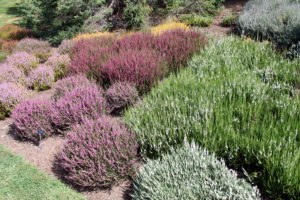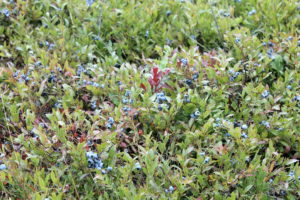Too Hot for These Plants
August 29th, 2017
We do a lot of fretting – and rightfully so – about whether plants are cold-tough enough to withstand our winters.

You’re unlikely to see heather growing like this in a south-central Pennsylvania garden. This mass of them is growing in Nova Scotia’s Royal Annapolis Garden.
Less attention gets paid to plants that are likely to croak in our yards because our climate is too hot for their liking.
You’ve probably run into this if you’ve killed lupines or heather. It wasn’t you or your lousy soil. It just gets too hot in summer around here for these cool-climate natives to thrive and survive.
You’ll notice this if you ever venture north, say, to Maine or the Canadian Maritimes where I led a group tour earlier this month.
See a collection of pictures from that trip on my Photo Gallery pages.
Up there, you won’t see crape myrtles, cherry laurels, nandinas or other Zone 6/7 borderline-hardy plants that we’ve been growing here quite well lately. But lupines grow like weeds on Canada’s Prince Edward Island, and hillsides of heathers grow as bullet-proof for New Brunswickers as barberries and ornamental grasses do for us.
The difference is in the genes. While some plants have evolved to deal with a wide range of temperatures, others are good at handling either heat or cold – but not both.
Longwood Gardens struggled for years trying to grow a hillside of heaths and heathers, but even those prestigious growers got tired of the death rate and converted the area to a blend of mostly native trees, shrubs and perennials.
That was a pretty good clue to me… if Longwood can’t overcome a growing challenge, I doubt I’m going to have much luck either.
Lady’s mantle – that yellow bloomer with the scalloped, fan-shaped leaves – is another perennial that was doing really well all over Maine and the Maritimes. I haven’t been able to keep them alive more than one or two summers in my Cumberland County yard despite good soil and adequate summer water.
Ditto for the dogwood-family groundcover called bunchberry (Cornus canadensis), the evergreen groundcover bearberry (Arctostaphylos uva-ursi), and the balsam fir (Abies balsamea), a short-needled conifer with a strong “piney” scent. All of these are in trouble on the warm side of Zone 6.
But the most striking example our tour group saw of “Plants We Can’t Grow Because It’s Too Hot” was the lowbush blueberry. This is an impressive performer if you’ve never seen it.
The lowbush blueberry is the forerunner of the highbush blueberry that we know and grow.
Lowbush blueberries are woody plants that hug the ground at under 1 foot and produce dark-blue fruits that are less than the size of peas. Some aren’t much bigger than BBs.
The fruits ripen in August instead of June and July, and because of their smaller package, they’re sweeter and drier than the bigger, more watery fruits that we get on our 4- to 5-foot highbush plants.
Lowbush blueberries are natives that grow wild all over the Northeast Atlantic, which is why they’re sometimes called “wild blueberries.”
We visited the family-run Welch Blueberry Farm near Machias, Maine, where fields full of blueberries have been growing wild for generations. Mainers and Maritimers practically worship this harvest every August, even though lowbush blueberries can’t compete commercially with the bigger-fruited highbush blueberries.
The farm’s owner Wayne Hanscom told us that highbush blueberries have a wider temperature range and so can be grown in more areas, meaning they can be made available to stores year round.
The poor, little, August-ready lowbush blueberries end up mainly frozen or packaged for baking use. Or devoured fresh by New Englanders and Maritimers.
“Lowbush berries don’t do well much south of New Hampshire,” Wayne says.
In hot weather, they tend to run into fatal fungal diseases, which is why you’ll seldom see them for sale in Pennsylvania.
That’s too bad for us because even not counting the tasty fruit, lowbush blueberries make an excellent groundcover that blooms white in late spring and then has leaves that turn glossy scarlet in fall.
Assuming our climate continues to heat up as it’s been doing, what we gain on the southern end, we may lose on the northern end.
An example of that could be the sugar maple – the symbol of the Canadian flag.
This glorious fall-foliage tree was once a solid performer in Pennsylvania, but I’ve been seeing more and more of them suffering – even dying – in the last 10 years or so.
Ones I’ve seen croak had no bug or diseases issues. They just “mysteriously” died (including one of my own). Researchers are looking into pollution and acid rain as possible explanations, but since this is a species that traditionally favors cool climates, it seems to me that warming climate is not going to make sugar maples happy.
If you want to read more about heat’s toll in the garden, I wrote a garden column a few years ago on how and why it can threaten plant health.
As things heat up, we can adapt by going into the air-conditioning. Plants are stuck to sweat it out. So if you’re eager to see lupines and heathers, looks like you’re going to have to travel north.








